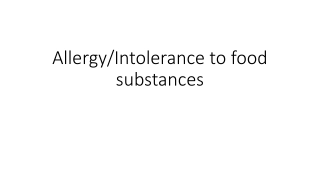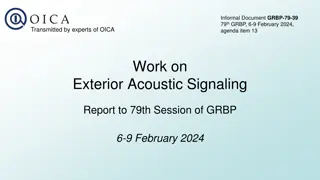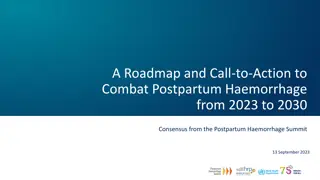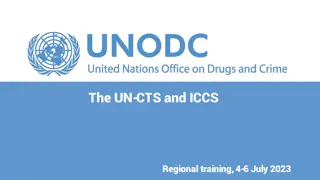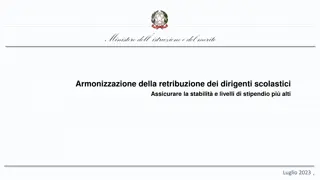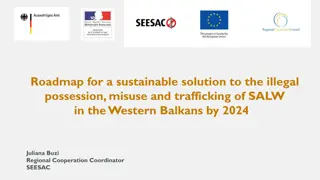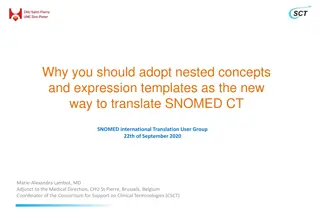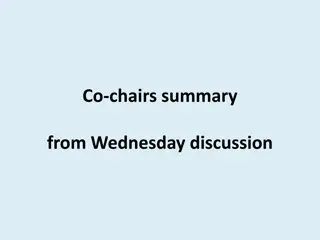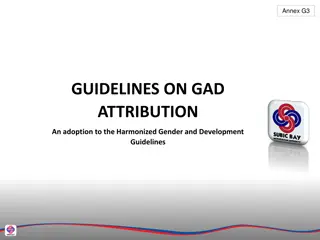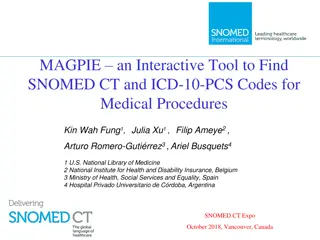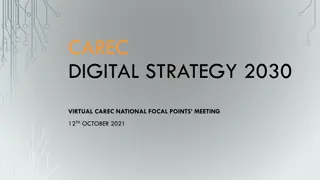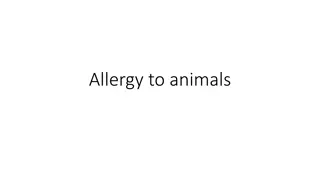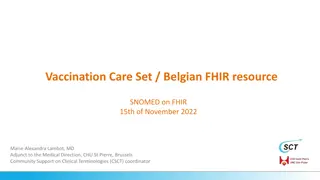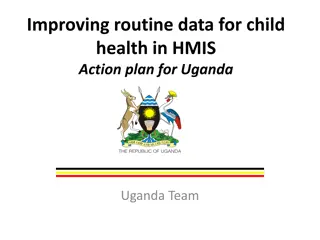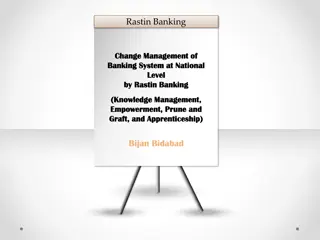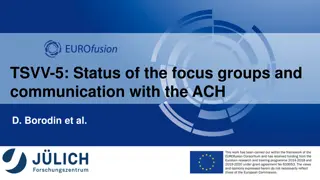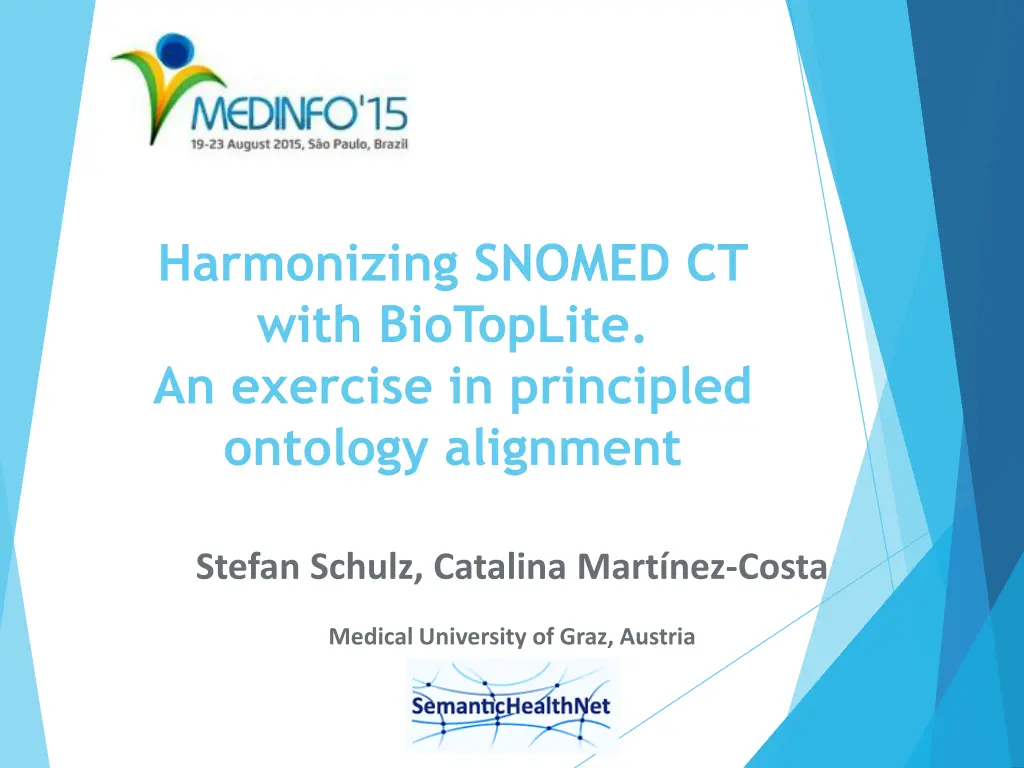
Ontology Alignment for Biomedical Information Interoperability
Explore the alignment of SNOMED CT with BioTopLite for semantic interoperability in exchanging biomedical information, addressing the challenge of diverse ontologies and the need for a shared top-level layer for enhanced alignment and consistency.
Download Presentation

Please find below an Image/Link to download the presentation.
The content on the website is provided AS IS for your information and personal use only. It may not be sold, licensed, or shared on other websites without obtaining consent from the author. If you encounter any issues during the download, it is possible that the publisher has removed the file from their server.
You are allowed to download the files provided on this website for personal or commercial use, subject to the condition that they are used lawfully. All files are the property of their respective owners.
The content on the website is provided AS IS for your information and personal use only. It may not be sold, licensed, or shared on other websites without obtaining consent from the author.
E N D
Presentation Transcript
Harmonizing SNOMED CT with BioTopLite. An exercise in principled ontology alignment Stefan Schulz, Catalina Mart nez-Costa Medical University of Graz, Austria
Semantic Interoperability Meaningful exchange of biomedical information requires support by ontologies and terminologies SNOMED CT and others (e.g. OBO Foundry ontologies, WHO classifications) have recognized the need of precise descriptions of the entities denoted by terms and concepts, their ontological nature and the way they are related They increasingly use a formal language, typically description logics (DL) axioms
Problem statement Numerous ontologies have been developed bottom-up in different contexts They do not share an joint upper-level. Key terms (e.g. disorder, animal, drug, situation, condition) have different meanings and often lack explicit definitions Alignment of lexical labels does not guarantee alignment of meaning Interoperability between semantic artefacts is facilitated by A well-understood and well performing representational language A top-level layer of shared categories and relations (Top level ontology)
Goal Analyse the ontological structure of the OWL version of SNOMED CT Upper level concepts (classes) Relations Constraints Manually align it with the Upper-Level Ontology BioTopLite2 (BTL2) Check for consistency and performance Assess feasibility of moving to a richer language as claimed by Rector & Brandt (2008) Rector AL, Brandt S. Why do it the hard way? The case for an expressive description logic for SNOMED. J Am Med Inform Assoc. 2008 Nov-Dec;15(6):744-751
Comparison Upper Level Classes SNOMED CT BioTopLite2 Body structure Clinical finding Environment or geogr. location Event Observable entity Organism Pharmaceutical/biologic product Physical force Physical object Procedure Qualifier value Record artefact Situation with explicit context Social context Special concept Specimen Staging and scales Substance Disposition Function Immaterial object Information object Material object Process Quality Role Temporal region Value region
Comparison Top Level of Relations SNOMED CT* BioTopLite2 Has interpretation Has specimen Interprets Laterality Method Occurrence Procedure context Procedure device Procedure site Procedure site - Indirect Role group Specimen source topography Subject relationship context Temporal context Using access device Using device Using substance Access After Associated finding Associated morphology Associated procedure Associated with Causative agent Component Direct device Direct morphology Direct substance Finding context Finding site Has active ingredient Has dose form Has focus Has intent at some time includes has part has boundary has granular part has component part is bearer of causes has realization precedes has condition projects onto has participant has agent has patient has outcome is life of is referred to at time represents Total 66, *most frequent, cover 95% Total 37, inverses not displayed
Mapping process Manual mapping of upper classes and relations Iterative approach: add map classify (using DL reasoning) satisfiability check: positive: check entailments if OK proceed to next mapping step negative: analyse error (explanation tool) fix error and classify again
Dealing with performance issues Problem: SNOMED CT is huge (300,000 concepts), but has OWL-EL expressiveness BTL2 has OWL-DL expressiveness Result: Performance inacceptable in described workflow Solution Instead of whole SNOMED CT, use random modules Module creation: maximal number of patterns maximal representativeness (pattern: unique combination of relations + concepts of a given subhierarchy) Module produced with a signature of one concept per patterns 11,000 concepts
Results: Class mappings Only one equivalence mapping: Organism Eight subclass mappings e.g. sct:Event subclassOf btl2:process Four complex subclass mappings e.g. sct:Finding subclassOf btl:process or btl:material entity or btl:disposition No mappings: sct:Qualifier value sct:Situation with explicit context sct:Social context sct:Special concept overly hetero- geneous
Results: relation mapping (I) Far more complex Do far only done for subset of relations Only one equivalence: sct:After btl2:precedes Context-dependent mapping, e.g. Findings:sct:RoleGroup btl2:hasCondition Procedures: sct:RoleGroup btl2:hasPart Most relations mapped as subrelations to BTL2 relations, with refined domains and ranges, e.g. sct:Finding site subrelation of btl:is included in with domain btl:condition and range sct:Body structure;
Results: relation mapping (II) Lossy mapping where exact meaning cannot be reconstructed by BTL2, e.g. sct:Procedure site - Indirect, sct:Direct morphology Complex relationships: shortcuts for composed expressions, e.g. sct:hasFocus: intent of a procedure to reach a certain goal. Would require model of intentionality sct:FindingContext: information model entity related to Finding: btl2:represents only (FindingX or (not Finding))
Performance issues Prot g explanation function Debugging of unsatisfiable expressions requires expertise and consumes time Classification time avg 15 min for modules in which all patterns are represented
Performance issues Debugging of unsatisfiable expressions requires expertise and consumes time Classification time avg 15 min for modules in which all patterns are represented
Performance issues Prot g explanation function Debugging of unsatisfiable expressions requires expertise and consumes time Classification time avg 15 min for modules in which all patterns are represented
Conclusion and Outlook Work in progress shows feasibility of workflow supports Rector & Brandt's (2008) arguments for a more expressive representation language Mappings depend on individual judgement by experts in both content and ontology Ontological commitment of SNOMED CT classes still under discussion (e.g. Findings / disorders as "Clinical Life Phases") Multitude of relations is a legacy issue reduction to much lesser relations possible without loss of precision Satisfiability check with constraining upper-level axioms potentially useful quality check in content production

